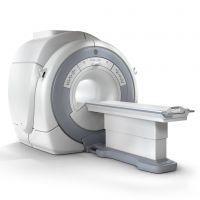1.5 Tesla MRT (magnetic resonance imaging) High-tech now also in the apex spine center
Warm welcome. In order to be able to offer our patients an even better service, the back and spine specialists at the apex spine center offer not only orthopedic neurological examinations, X-rays of your spine if necessary, spine motion analysis (EMG) including mobility and muscle reaction tests, strength tests using MedX , blood tests if necessary, now also thanks to one of the most modern 1.5Tesla MRI or nuclear spin tomoigraph high-resolution images of your spine.
Magnetic resonance imaging works without X-rays! 
You will receive all necessary examinations and a written summary of the findings including a therapy proposal on the same day!
Latest MRI technology in the apex spine center!
A 1.5 tesla MRT device of the latest generation has recently been available for you as a patient in our premises. With this new device, the sometimes long examination times are significantly reduced.
What advantages do you as a patient have from MRI diagnostics directly at the apex spine?
For you as a patient, there are no unnecessary delays and waiting times until all the necessary examinations have been completed.
Your advantage: after your visit to our spine center, you go home with a written report including a diagnosis and a suggested treatment. This saves you longer delays and you know with just one visit where the cause of your problem lies.
What is magnetic resonance imaging?
Magnetic resonance imaging (MRI), also known as nuclear spin tomography, is an imaging method for generating cross-sectional images of the entire body. Due to the high-contrast tissue display, internal structures such as a herniated disc, bony stenoses, tumors or foci of infection can be displayed exactly. Magnetic resonance tomography has been used successfully in medical diagnostics worldwide since the mid-1980s.
How does magnetic resonance imaging (MRI) work
MRI does not use X-rays, just a strong magnetic field and radio frequency waves - similar to those used by radio stations. Highly sensitive antennas pick up the necessary information from the body. These signals are then converted into sectional images of the body with the help of computers. As a result, the patient is not exposed to X-rays.

